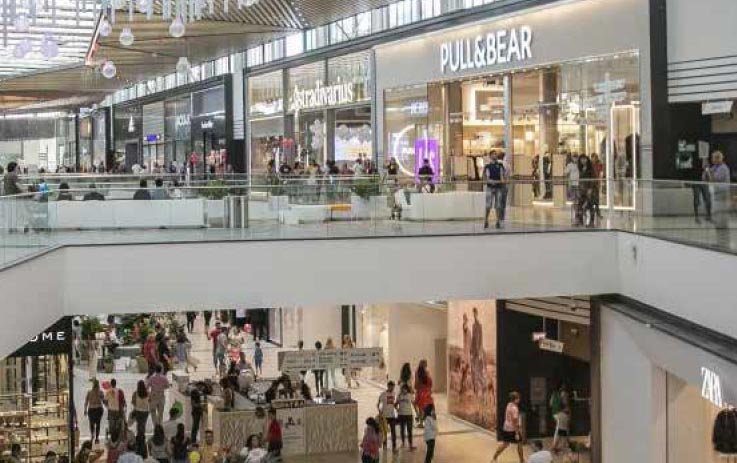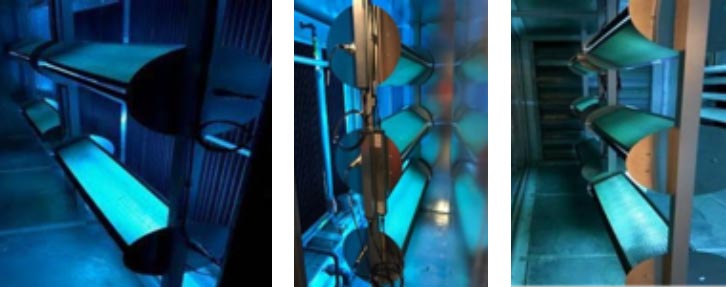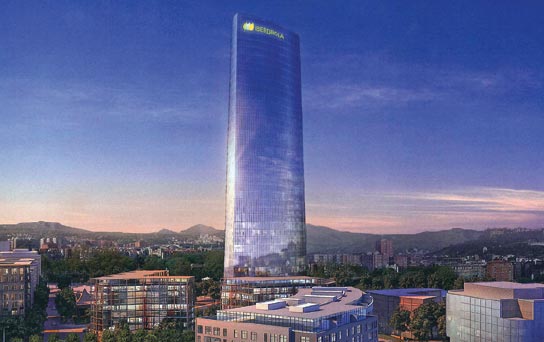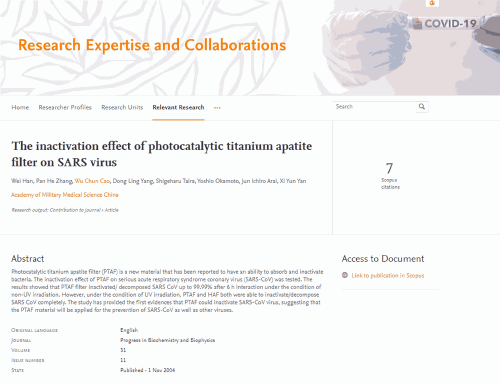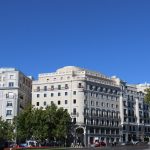Buildings as a preventive barrier against COVID-19
Situations like COVID-19 are not rare occurrences
In the last 17 years, there have been at least 6 outbreaks (including the current one) which have affected the world population (SARS, MERS, Avian Flu, ZIKA and EBOLA).
Highly valuable work can be done to prevent the impact of situations like COVID-19 by improving the indoor environmental conditions of office buildings.
The high likelihood of airborne transmission of SARS-CoV-2 requires airborne exposure to the virus to be controlled. The way in which buildings operate, including their air conditioning and ventilation systems, must be changed.
What measures can be taken?
Photocatalytic Filters (SFEG® Systems)
Composition and functions
This system comprises a honeycomb catalyst coated in Titanium Dioxide and ultraviolet germicidal light-emitting diodes (259nm).
It is designed to treat ventilation/air conditioning system air flows, reducing the risk of contamination with chemical compounds (NOx, VOCs, SO2, etc.) and microorganisms (Viruses, Bacteria, Fungi, Yeasts).
Characteristics
It combines UVGI ultraviolet germicidal light and oxidation by means of hydroxyl radicals, as well as deactivating the DNA of microorganisms.
SFEG® photocatalytic filters are made to suit the characteristics of each project. They can be installed in both
air conditioning systems and ducts.
They are installed by irradiating the surface of the batteries to ensure that these stay clean and consume less energy.
One advantage of ultraviolet germicidal irradiation systems (UVC) is that this system acts both on the interior surface of the air conditioning system as well as on the air flow.
Advantages
Compliance with RITE regulations
RITE (Regulations on Thermal Installations in Buildings, RD 1027/2007) REQUIRE the ventilation and air conditioning installations of buildings to meet minimum requirements for energy efficiency and indoor air quality (Art.11).
| Exterior | Interior | |||
|---|---|---|---|---|
| IDA 1 | IDA 2 | IDA 3 | IDA 4 | |
| ODA 1 | F9 | F8 | F7 | F5 |
| ODA 2 | F7+F9 | F6+F8 | M5+F7 | M5+M6 |
| ODA 3 | F7+GF*+F9 | F7+GF+F9 | M5+F7 | M5+M6 |
*GF= Gas Filter (carbon filter) and/or chemical or physical-chemical filter (photocatalytic) and will only be required if ODA 3 is reached due to excess gases.
Examples of installations
Banco Santander. Abelias Building

OBJECTIVES AND DESCRIPTION
The Banco Santander Abelias Building located at C/ de las Abelias in Madrid, is a complex of 54,300 square metres distributed over seven floors and three underground parking levels, and accommodates around 1,600 employees.
Banco Santander has completed this project in the building located in the Madrid neighbourhood of Palomas with the aim of improving air quality and reducing the building’s energy consumption. The Project Manager for this project was Bovis.
The installation of SFEG® Photocatalysis Systems is in line with an improvement in indoor air quality and the building currently has the LEED® Gold certification.
INSTALLATION DATA
Aire Limpio has worked on the project with the installation of 3 SFEG® systems in the AHUs that service the Headquarters. In addition to the benefits of improving indoor air quality, SFEG® systems generate energy savings.
| Sistemas de Fotocatálisis | |
|---|---|
| Model | SFEG |
| Nº of Units | 3 |
| Reduction in microbial load | >99% |
ADVANTAGES
POSSIBLE LEED CREDITS
![]() Energy & Atmosphere
Energy & Atmosphere
![]() Indoor Environmental Quality
Indoor Environmental Quality
![]() Innovation
Innovation
Lagoh Shopping Centre

OBJECTIVES AND DESCRIPTION
The Lagoh Shopping Centre, with a total of 100,000 m2 of commercial and leisure areas, is located in Sevilla and expects to receive 14 million visits a year, making it the largest shopping centre in the province.
For the Facilities Management team, it is very important to provide the visitor with the best possible shopping experience, especially in terms of health and comfort, with the highest levels of Indoor Air Quality.
With the integration of the Aire Limpio SFEG systems into the AHUs, indoor air quality is improved and the energy consumption of the air conditioning system is reduced.
The installation of SFEG Systems is in line with the efficiency and sustainability criteria chosen by Grupo Lar for its shopping centres and Lagoh has the BREEAM Sustainable Construction Certificate.
INSTALLATION DATA
Aire Limpio has worked on the project with the installation of SFEG systems in the AHUs that provide service to the shopping centre. The flow range varies between 5,000 m3/hour and 50,000 m3/hour. In addition to the benefits of improving indoor air quality, SFEG systems generate energy savings.
| Sistemas de Fotocatálisis | |
|---|---|
| Reduced loss of battery charge | 29,50% |
| Reduction ΔT in outgoing air | 4,20% |
| Increase ΔT in battery water | 6,10% |
| Reduction in microbial load | >99% |
ADVANTAGES
POSSIBLE LEED CREDITS
![]() Energy & Atmosphere
Energy & Atmosphere
![]() Indoor Environmental Quality
Indoor Environmental Quality
![]() Innovation
Innovation
Edificios Majadahonda y Palacio Montepilar

Objetivos y descripción
Mapfre Inmuebles es la filial encargada en dar Servicios Inmobiliarios del Grupo Mapfre entre los que se encuentra, entre otros, la Gestión de Patrimonio Inmobiliario, la Gestión de los Proyectos y la Gestión del Mantenimiento y Conservación de los Edificios.
Durante el 2011 Mapfre Inmuebles ha realizado una serie de medidas para implantar tecnologías de ahorro energético y purificación de aire interior en los sistemas de ventilación.
Aire Limpio ha participado en el diseño y la instalación de los sistemas de purificación de aire utilizando las tecnologías de Fotocatálisis en los edificios de la sede central de Majadahonda y el Palacio Montepilar.
Datos de la instalación
Aire Limpio ha colaborado en el proyecto con la instalación de 3 sistemas SFEG® en las UTAs que dan servicio a la Sede. Además de las prestaciones en la mejora de la calidad del aire interior, los sistemas SFEG® generan ahorro energético.
Complejo Majadahonda
| UTAs | 2 UTA en cubierta | 2 UTA en cubierta |
|---|---|---|
| Caudales | 30.000 m3/hora | 23.000 m3/hora |
| Filtración de Gases | Sistemas Fotocatálisis SFEG© PCO30 de Aire Limpio |
Sistemas Fotocatálisis SFEG© PCO23 de Aire Limpio |
| Pérdida de carga Irradiación UVGI Catalizador |
20 Pa 19.000 μW/cm2 Reactor monolítico |
19 Pa 11.400 μW/cm2 Reactor monolítico |
| Fecha de puesta en marcha | Diciembre de 2011 | |
| Ahorro de costes de energía y mantenimiento | 15.795 € /anuales |
Palacio Montepilar
| UTAs | 1 UTA | 2 UTA | 3 UTA |
|---|---|---|---|
| Caudales | 4.000 m3/hora | 9.000 m3/hora | 8.000 m3/hora |
| Filtración de Gases | Sistemas Fotocatálisis SFEG© PCO4 de Aire Limpio |
Sistemas Fotocatálisis SFEG© PCO9 de Aire Limpio |
Sistemas Fotocatálisis SFEG© PCO8 de Aire Limpio |
| Pérdida de carga Irradiación UVGI Catalizador |
18 Pa 3.800 μW/cm2 Reactor monolítico |
19 Pa 11.400 μW/cm2 Reactor monolítico |
19 Pa 11.400 μW/cm2 Reactor monolítico |
| Fecha de puesta en marcha | Febrero de 2011 | ||
| Ahorro de costes de energía y mantenimiento | 4.470 € /anuales |
Ventajas
Créditos LEED posibles
![]() Energy & Atmosphere
Energy & Atmosphere
(Energía y Atmósfera)
![]() Indoor Environmental Quality
Indoor Environmental Quality
(Calidad de ambiente interior)
![]() Innovation
Innovation
(Innovación)
What does the scientific community say?
Position Document on Infectious Aerosols

ASHRAE
UVGI inactivates microorganisms by damaging the structure of nucleic acids and proteins with an efficacy that depends on the UV dose and the susceptibility of the microorganism. The most important of these is deoxyribonucleic acid (RNA), which is responsible for molecular reproduction. The safety of UV-C is well known.
The Centres for Disease Control and Prevention (CDC) has approved UVGI as an adjunct to filtration in reducing the risk of tuberculosis, and published a guideline on its application (CDC 2005, 2009).7 (Evidence Level A).
A.Highly recommended; good evidence
B. Recommended, at least consistent evidence.
C.No recommendation for or against; benefits and harms too closely balanced to warrant a recommendation.
D.Recommend against; consistent evidence is ineffective or the harm outweighs the benefit.
E.Insufficient evidence to make a recommendation for or against on a routine basis;
The inactivation effect of photocatalytic titanium apatie on SARS Virus
Han Wei, Zhang Banhe, Cao Wuchun, Yang Dongling, Taira I, Okamoto Y, Arai JI, Yan Xiyun
UVGI inactivates microorganisms by damaging the structure of nucleic acids and proteins with an efficacy that depends on the UV dose and the susceptibility of the microorganism. The most important of these is deoxyribonucleic acid (RNA), which is responsible for molecular reproduction. The safety of UV-C is well known.
The Centres for Disease Control and Prevention (CDC) has approved UVGI as an adjunct to filtration in reducing the risk of tuberculosis, and published a guideline on its application (CDC 2005, 2009).7 (Evidence Level A).
Characterisation and photocatalytic treatment of indoor air Fungi and Bacteria
CIEMAT, Centre for Molecular Biology ‘Severo Ochoa’.
The effectiveness of this type of filter in moving air has been studied extensively.
In summary
Offices should integrate systems and practices that promote the health and well-being of their occupants, thus making offices more resilient spaces that are better armed against physical pollutants and microorganisms
Aire Limpio offers the different technologies that are recommended by reputable world organisations







